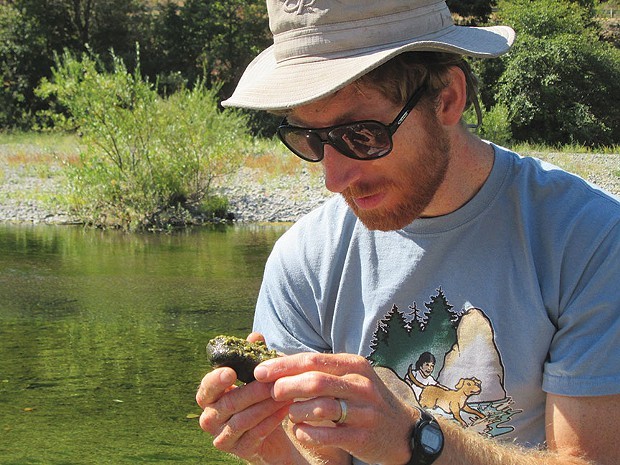Wednesday, August 20, 2014
Algae Toxins in the Trinity
Posted By Heidi Walters on Wed, Aug 20, 2014 at 4:59 PM
These may be the dog days of summer, but ol' Rex and Rusty better be careful about what rivers and lagoons they go jumping in to celebrate: The poor dogs don't want to encounter toxic blue-green algae, which can thrive in the low flows and warm water conditions we're seeing now on local rivers including the South Fork Eel, Van Duzen, Mad, Klamath and Trinity. In fact, a news release from the Humboldt County Department of Health and Human Services (DHHS) warns that toxins associated with blue-green algae have recently been detected in the Trinity River.
"Blue-green algae can be present in any fresh water body," says the release. "It looks like green, blue-green, white or brown scum, foam or mats floating on the water. Usually it does not affect animals or people. However, warm water and abundant nutrients can cause blue-green algae to grow more rapidly than usual. These floating algal masses or 'blooms' can produce natural toxins that are very potent. Dogs and children are most likely to be affected because of their smaller body size and tendency to stay in the water for longer periods of time."
The DHHS says it knows at least 11 cases since 2001 in which dogs died possibly because of exposure to the toxin after swimming in Big Lagoon, the South Fork Eel River and the Van Duzen River.
Kids, other pets, livestock and adults also should avoid swimming in or drinking from water bodies containing the tell-tale algal scum mats. Not all algae is toxic, such as green algae, notes the DHHS, but it says to play it safe.
Blue-green algae that produce liver toxins have been documented in Klamath River reservoirs and the Klamath River this year and in past years. You can look up the status of such reports at the Klamath Basin Monitoring Program website: http://www.kbmp.net/maps-data/blue-green-algae-tracker.
You can learn more about other efforts to understand blue-green algae in North Coast Journal freelancer Jacob Shafer's Sept. 19, 2013 piece, "Slime Questions."
Here's more on the possible symptoms of blue-green algae toxin exposure, and on the things that you — you people — can do to help reduce the growth of toxic algae, from the news release:
Potential symptoms in dogs following exposure to blue-green algae toxins can include lethargy, difficulty breathing, salivation, vomiting, urination, diarrhea, or convulsions. People can experience eye irritation, skin rash, mouth ulcers, vomiting, diarrhea, and cold or flu-like symptoms. While there is no antidote for exposures, persons should see their physician and those with pets which may have been exposed should go to their veterinarian for supportive care.
DHHS officials recommend the following guidelines for recreational users of all freshwater areas in Humboldt County:
Keep children, pets and livestock from swimming in or drinking water containing algal scums or mats.
Adults should also avoid wading and swimming in water containing algal blooms. Try not to swallow or inhale water spray in an algal bloom area.
If no algal scums or mats are visible, you should still carefully watch young children and warn them not to swallow any water.
Fish should be consumed only after removing the guts and liver and rinsing fillets in tap water.
Never drink, cook with or wash dishes with water from rivers, streams or lakes.
Get medical attention immediately if you think that you, your pet, or livestock might have been poisoned by blue-green algae toxins. Be sure to tell the doctor about possible contact with blue-green algae.
Human activities can have a big effect on nutrient and water flows in rivers, streams or lakes. Phosphorous and nitrogen found in fertilizers, animal waste, and human waste can stimulate blooms. Excessive water diversions can increase water temperatures and reduce flows. People can take the following measures to prevent algal blooms in our waters:
Be very conservative with the use of water, fertilizers and pesticides on your lawn, garden or agricultural operation.
Recycle any “spent” soil that has been used for intensive growing by tilling it back into gardens. Or protect it from rainfall to avoid nutrient runoff.
Plant or maintain native plants around banks. These plants help filter water and don’t require fertilizers.
Pump and maintain your septic system every three to four years.
Prevent surface water runoff from agricultural and livestock areas.
Prevent erosion around construction and logging operations.
Join or support one of the many watershed and river organizations.
Contact the Humboldt County DHHS Division of Environmental Health at 445-6215 or 1-800-963-9241 for more information. People may report unusual blooms or conditions, including pictures, to Environmental Health by emailing [email protected]. For more details, visit the California Department of Public Health’s website: www.cdph.ca.gov/healthinfo/environhealth/water/Pages/bluegreenalgae.aspx.
Speaking of...
-

Hoopa Resident, 26, Killed in Single-Car Crash
Nov 9, 2023 -

Birding with Dogs
Sep 14, 2023 -

FAQ About Your Changing Body
Aug 31, 2023 - More »
Comments
Showing 1-1 of 1
Readers also liked…
more from the author
-
From the Journal Archives: When the Waters Rose in 1964
- Dec 26, 2019
-
Bigfoot Gets Real
- Feb 20, 2015
-
Lincoln's Hearse
- Feb 19, 2015
- More »
































